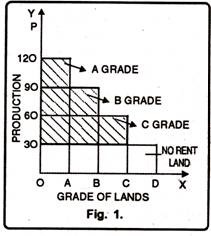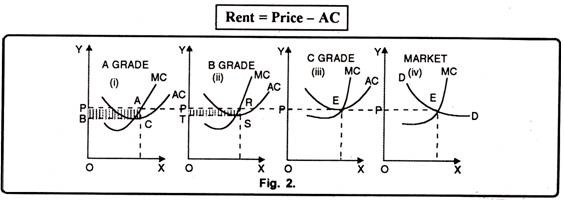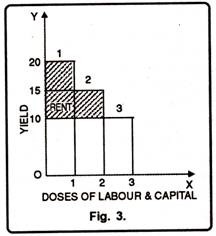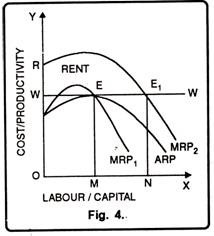According to Ricardo, rent can be determined in three forms as:
1. Extensive cultivation, 2. Intensive cultivation, 3. Situation of Land.
1. Rent in Extensive Cultivation:
Extensive cultivation refers to the farming system under which in order to increase the agricultural production, the area under cultivation is extended.
Therefore, under extensive cultivation, more output is produced by increasing the quantity of land.
ADVERTISEMENTS:
To explain, how rent arises, David Ricardo took the case of a newly developing island where land is far in excess of what is required for the people living there.
He further assumed that there exists four types of land viz.; A, B, C, D. Some pieces of land are more fertile than others and some areas are more advantageously situated. But taking all the factors into consideration, suppose A is more fertile land and B, C, D are 2nd, 3rd and 4th grades of land. It can be explained with the help of an example.
According to this theory, people in the newly settled country will cultivate first of all the best grade i.e. A grade land. In the new country in the initial stages there will be sufficient supply of A grade land. Hence no one will be willing to pay anything for the use of land.
Rent will not come into existence at this stage. Price of the produce say wheat will, in the long run tend to be equal to the marginal cost of production and no surplus will be left with the producers. Now, with the increase in population, B grade land will be brought under cultivator. With the same quantity of labour and capital applied and with the same method of cultivation, B grade land will yield lower quantity of produce. Let us suppose that with the investment of labour and capital worth Rs. 100/- A grade land yields 120 quintals of wheat, whereas B grade land which is less fertile land, yields 90 quintals of wheat.
ADVERTISEMENTS:
It means that 90 quintals of wheat must sell at a price enabling the owners of B grade land to recover the expenditure of Rs. 100/ -. Now the price of wheat in the market whether raised from A grade land or B grade land must be the same. It means that owners of a grade land will be left to recover the cost of cultivation of wheat by selling only 90 quintals out of the total produce of 120 quintals. Thus they will be left with surplus of 30 quintals of wheat.
It makes no difference to the cultivator of land whether he cultivates B grade land and gets 90 quintals of wheat or A grade land from which he gets 120 quintals of wheat, if he has to pay a rent of 30 quintals to the owners of A grade land for the right to cultivate A grade land. As soon as B grade land is taken up for cultivation, the owner of A grade land enjoys a surplus. This surplus constitutes the rent on a grade land.
If, however, owing to a further increase of population, the supply of B grade land is exhausted. It will become necessary to cultivate C grade land. As per our supposition, amount of labour and capital worth Rs. 100/- will be invested in it. Since C grade land is inferior to B grade land, therefore, let it be supposed that C grade land will yield only 60 quintals of wheat.
Now wheat will have to be sold at as much price as will recover the cost of cultivation of C grade land. It means owners of A and B grades of land will come to enjoy a surplus of 60 and 30 quintals respectively. In course of time, D grade land will also come under cultivation.
ADVERTISEMENTS:
Suppose its yield is 30 quintals only. It will raise the surplus or economic rent of A, B and C grades of land. A grade land will get the maximum surplus and B and C grades of land will get a little less than A grade land over D grade land. D grade land does not enjoy any rent since it is land at the margin or it is marginal land.
It can be explained with the help of a table.
Table 1 shows that more and more of inferior land is brought under cultivation:
Remember superior land earns a surplus. In our example, D is the land whose cost of production is just covered by market price. It does not get any rent. It is the ‘no rent land’. On the other hand, A, B and C lands earn a differential surplus. Here it should be remembered that when only A was cultivated, it was not a ‘no rent land’. When B was brought under cultivation, A became rent earning land. Similarly B and C became rent-earning lands only when C and D grades of land were cultivated respectively. Thus the surplus of the earlier lands goes on increasing.
This fact can be explained with the help of the following figure:
In the Fig. 1 OY-axis represents yield that may be obtained from different grades of land with equal application of labour and capital. OX-axis shows different grades of land. As per figure, D grade land is the marginal or no-rent land. It is a land at the margin of cultivation. A grade land will be the first to be used. It is supposed to yield 100 quintals of wheat. Only when this land has been entirely occupied that people will take up the cultivation of B grade land.
After the land of B grade has been occupied, an increasing population will force the cultivation of C grade land. With further increase in population, D grade land or marginal land will be brought under cultivation. D grade can be called no rent land since it is at the margin of cultivation. The price of the produce will be in accordance with the marginal cost of cultivation on the D grade or the marginal land. Therefore, a surplus will appear on the superior or super-marginal lands.
ADVERTISEMENTS:
This surplus or rent is the difference in the quantity produced on the superior grade of land than that produced on the marginal land. In the above diagram, the shaded area indicates the rent. Here it is clear that the marginal land plays an important role in the determination of the economic rent.
Determination of Rent by Cost Curves:
The determination of rent can also be explained with the help of cost curves. Suppose, there exists perfect competition in the economy. Demand for wheat has increased to such an extent that farmers are compelled to cultivate even the most inferior land. Difference between price of wheat and its average cost of production measures economic rent. Thus:
In Fig. 2 (iv) OP price of wheat is determined and this price will be charged by the producers of A, B and C grade land owners. In fig. 2 (i) at OP price, rent on A-grade land is PACB. In fig. 2 (ii) at OP price, rent on B grade land is PRST whereas in fig. 2 (iii) on C-grade land at OP price, there is no-rent because its average cost is equal to price. Therefore, it is called marginal land.
2. Rent under Intensive Cultivation:
ADVERTISEMENTS:
Intensive cultivation refers to that type of farming in which increase in agricultural production, is brought about only by applying more units of labour and capital on the same piece of land. In other words, the area under intensive cultivation remains the same.
Ricardo assumes that the law of diminishing returns operates in agriculture i.e. when more and more units of labour and capital are put to use on the same piece of land, production increases at a diminishing rate. That means marginal product diminishes.
In the Figure 3 along OX-axis we represent doses of labour and capital of equal value and along OY-axis the produce raised. The first dose of labour and capital yields output shown by the area of rectangle No. 1, the second dose brings in yield indicated by the area of rectangle No. 2 and the third dose yields output shown by rectangle No.
3. If the producer thinks it just worth his while to apply the third dose, then price of they produce raised will be determined by the last or marginal dose.
ADVERTISEMENTS:
Measuring upwards from the marginal dose, all earlier doses yield a surplus or rent. Here rent emerges entirely due to natural conditions. The rent will emerge in the first dose and the second dose over the third dose which happens to be the marginal dose, as shown in the shaded area of the diagram. If the producer stops at the second dose then this dose will become the last or the marginal dose and in that case rent will arise only in the case of first dose as explained by the dotted line in the diagram.
Determination of Rent by Revenue Curves:
Now supposes that initially ARP in the average revenue productivity and MRP1 is the marginal revenue productivity of land at given price. At point E, ARP and MRP1 and WW are equal to one another. Thus, it is the equilibrium situation.
In this situation, OM units of labour and capital will be employed. Here, no rent will arise because cost and productivity are equal. Again suppose that due to rise in the price of produce of land MRP1 shifts upward and assumes the form of MRP2. New equilibrium will resort at point E1. It indicates that more units of labour and capital than before i.e. ON units. Total output will be WRE1N. This surplus WRE1 increase will be termed as rent.
3. Situation Rent:
Situation rent is regarded as that type of rent which arises due to difference in the situation of land. The land which is situated near the market will yield more rent as compared to land situated away from market. It is so because the produce of the land situated near the market can be transported at the small expenses.




